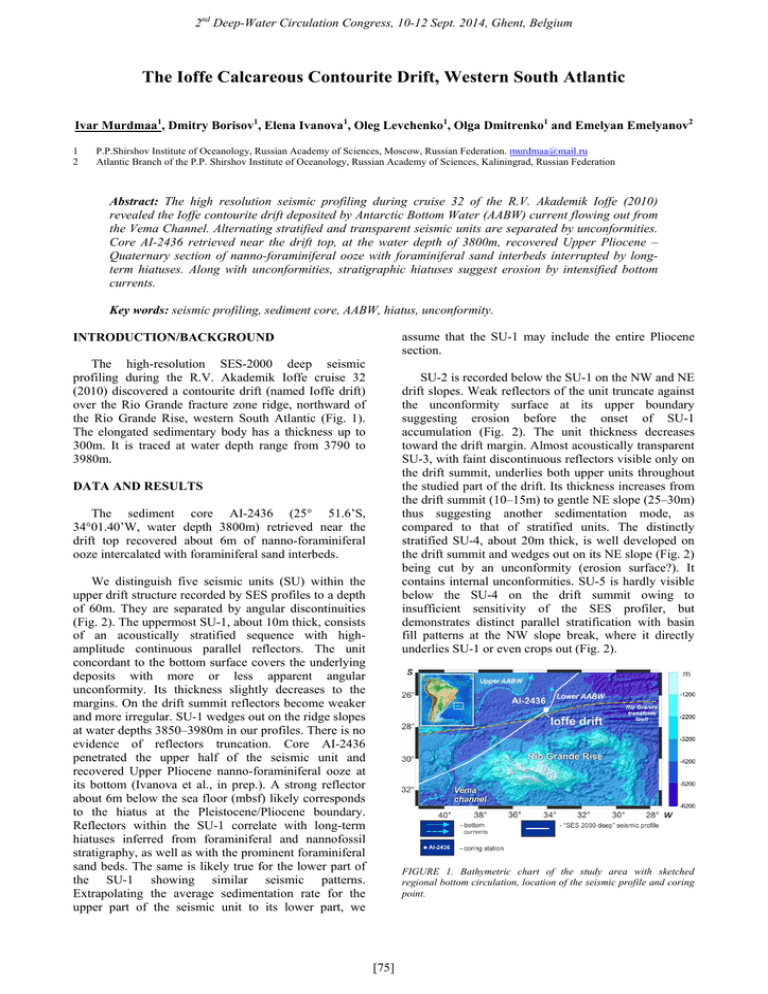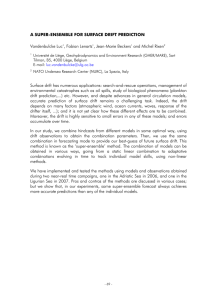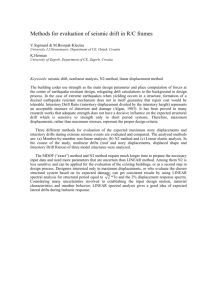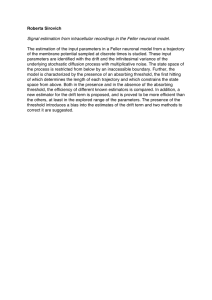The Ioffe Calcareous Contourite Drift, Western South Atlantic 2
advertisement

2nd Deep-Water Circulation Congress, 10-12 Sept. 2014, Ghent, Belgium The Ioffe Calcareous Contourite Drift, Western South Atlantic Ivar Murdmaa1, Dmitry Borisov1, Elena Ivanova1, Oleg Levchenko1, Olga Dmitrenko1 and Emelyan Emelyanov2 1 2 P.P.Shirshov Institute of Oceanology, Russian Academy of Sciences, Moscow, Russian Federation. murdmaa@mail.ru Atlantic Branch of the P.P. Shirshov Institute of Oceanology, Russian Academy of Sciences, Kaliningrad, Russian Federation Abstract: The high resolution seismic profiling during cruise 32 of the R.V. Akademik Ioffe (2010) revealed the Ioffe contourite drift deposited by Antarctic Bottom Water (AABW) current flowing out from the Vema Channel. Alternating stratified and transparent seismic units are separated by unconformities. Core AI-2436 retrieved near the drift top, at the water depth of 3800m, recovered Upper Pliocene – Quaternary section of nanno-foraminiferal ooze with foraminiferal sand interbeds interrupted by longterm hiatuses. Along with unconformities, stratigraphic hiatuses suggest erosion by intensified bottom currents. Key words: seismic profiling, sediment core, AABW, hiatus, unconformity. assume that the SU-1 may include the entire Pliocene section. INTRODUCTION/BACKGROUND The high-resolution SES-2000 deep seismic profiling during the R.V. Akademik Ioffe cruise 32 (2010) discovered a contourite drift (named Ioffe drift) over the Rio Grande fracture zone ridge, northward of the Rio Grande Rise, western South Atlantic (Fig. 1). The elongated sedimentary body has a thickness up to 300m. It is traced at water depth range from 3790 to 3980m. SU-2 is recorded below the SU-1 on the NW and NE drift slopes. Weak reflectors of the unit truncate against the unconformity surface at its upper boundary suggesting erosion before the onset of SU-1 accumulation (Fig. 2). The unit thickness decreases toward the drift margin. Almost acoustically transparent SU-3, with faint discontinuous reflectors visible only on the drift summit, underlies both upper units throughout the studied part of the drift. Its thickness increases from the drift summit (10–15m) to gentle NE slope (25–30m) thus suggesting another sedimentation mode, as compared to that of stratified units. The distinctly stratified SU-4, about 20m thick, is well developed on the drift summit and wedges out on its NE slope (Fig. 2) being cut by an unconformity (erosion surface?). It contains internal unconformities. SU-5 is hardly visible below the SU-4 on the drift summit owing to insufficient sensitivity of the SES profiler, but demonstrates distinct parallel stratification with basin fill patterns at the NW slope break, where it directly underlies SU-1 or even crops out (Fig. 2). DATA AND RESULTS The sediment core AI-2436 (25° 51.6’S, 34°01.40’W, water depth 3800m) retrieved near the drift top recovered about 6m of nanno-foraminiferal ooze intercalated with foraminiferal sand interbeds. We distinguish five seismic units (SU) within the upper drift structure recorded by SES profiles to a depth of 60m. They are separated by angular discontinuities (Fig. 2). The uppermost SU-1, about 10m thick, consists of an acoustically stratified sequence with highamplitude continuous parallel reflectors. The unit concordant to the bottom surface covers the underlying deposits with more or less apparent angular unconformity. Its thickness slightly decreases to the margins. On the drift summit reflectors become weaker and more irregular. SU-1 wedges out on the ridge slopes at water depths 3850–3980m in our profiles. There is no evidence of reflectors truncation. Core AI-2436 penetrated the upper half of the seismic unit and recovered Upper Pliocene nanno-foraminiferal ooze at its bottom (Ivanova et al., in prep.). A strong reflector about 6m below the sea floor (mbsf) likely corresponds to the hiatus at the Pleistocene/Pliocene boundary. Reflectors within the SU-1 correlate with long-term hiatuses inferred from foraminiferal and nannofossil stratigraphy, as well as with the prominent foraminiferal sand beds. The same is likely true for the lower part of the SU-1 showing similar seismic patterns. Extrapolating the average sedimentation rate for the upper part of the seismic unit to its lower part, we FIGURE 1. Bathymetric chart of the study area with sketched regional bottom circulation, location of the seismic profile and coring point. [75] 2nd Deep-Water Circulation Congress, 10-12 Sept. 2014, Ghent, Belgium Long term hiatuses in the core section and angular unconformities in seismic profiles indicate that the drift accumulation was several times interrupted by erosion owing to the strong increase in bottom current velocities. DISCUSSION High resolution seismic profiling and multiproxy studies of the core AI-2436 revealed typical contourite features of the Ioffe drift, such as morphology, internal stratified structure with numerous unconformities, stratigraphic hiatuses, alternation of calcareous sediment layers of different color and grain size distribution from fine-grained foram-nanno ooze to foraminiferal sand. The calcareous contourite drift was deposited as a result of biogenic calcareous material transport by the eastern branch of the Antarctic bottom water (AABW) flow (Morozov and Tarakanov, in press). The biogenic material is mainly derived from the Rio Grande Rise where planktonic foraminiferal and nannofossil assemblages identical to those in core AI-2436 (Ivanova et al., in preparation) are studied at the DSDP site 516 (Barash et al., 1983). Stratigraphic hiatuses in the core, as well as unconformities in seismic profiles indicate episodes of considerable increase in the AABW bottom current velocity. Stratified seismic units and layered sedimentary structure of the core suggest pulsating sedimentation of contourites driven by the bottom current fluctuation. ACKNOWLEDGEMENTS This work was supported by RFBR, research project 14-05-00744. REFERENCES Barash, M.S., Oskina, N.S., Blyum, N., S., 1983. Quaternary biostratigraphy and surface paleotemperatures based on planktonic foraminifers. In: Barker, P.F., Carlson, R.L., Johnson, D.A., et al. (eds.), Initial Reports of the Deep Sea Drilling Project (U.S. Govt. Printing Office), 72, 849-869, doi:10.2973/dsdp.proc.72.142.1983 Ivanova, E.V., Murdmaa, I.O., Borisov, D.G., Levchenko, O.V, Dmitrenko, O.B., Emelyanov, E.M. The Neogene-Quaternary Ioffe drift formation, SW Atlantic. (in preparation). Morozov, E. G. and Tarakanov, R. Yu., in press. The Flow of Antarctic Bottom Water from the Vema Channel to the Brazil Basin. Doklady Earth Sciences. CONCLUSIONS The Ioffe calcareous contourite drift is deposited on the Rio Grande fracture zone ridge by the eastern branch of the AABW bottom current bifurcated near the outlet from the Vema Channel. FIGURE 2. Seismic profiles running roughly along (A) and across (B) the Ioffe drift crest. [76]





